The SFist’s Sarah L. has a first-hand report of the first Survival Research Labs show in ten years. If the name sounds familiar, that’s because none other than William T. Vollmann chronicled the SRL’s theatrical destruction of machines in a section of The Rainbow Stories. Will there be more shows? Well, who knows? But Your Faithful Correspondent will try and get the inside skinny on this.
Category / San Francisco
Josh Wolf Benefits
To follow up on the Josh Wolf incarceration, Laughing Squid points to two benefit events designed to raise money for Josh’s legal defense fund.
Event #1: Cafe La Boheme, Saturday August 19, 2006, 5:00 PM-7:00 PM.
Event #2: House of Shields, Thursday, August 24, 2006, 7:00 PM.
Josh’s case represents a scenario that could apply to all journalists, establishing a legal precedent which will affect the way any story is covered. That local story about police corruption involving a reporter gaining the trust of an anonymous source? (Consider Fajitagate, for example.) Well, the case is under investigation and it’s been transferred to a federal court, sidestepping the California shield law, and the journalist has to give up his sources or be thrown in jail. If you are concerned with preserving California’s shield law and the future of investigative journalism, and you happen to be in San Francisco on either of these two days, these two benefits are worth your while.
RIP Sue Bierman
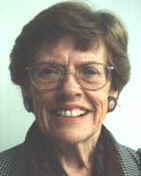 Former San Francisco Sue Bierman died today. She apparently crashed her car into a dumpster in Cole Valley. Bierman was always one of my favorite supervisors and I certainly missed her when term limitations forced her out of office. Now I’ll miss her even more.
Former San Francisco Sue Bierman died today. She apparently crashed her car into a dumpster in Cole Valley. Bierman was always one of my favorite supervisors and I certainly missed her when term limitations forced her out of office. Now I’ll miss her even more.
While she got a late start in politics (she was 68 when she first became Supervisor), Bierman brought a compassionate touch and a wise, no-bullshit voice of skepticism to almost every issue she took on. It was Bierman who stopped the freeway from expanding into the Panhandle.
Bierman offered a progressive voice that was distinctly San Franciscan: tolerant, quirky, and independent. She frequently adopted interesting and controversial positions, such as voting against an alcohol ban in the Panhandle, arguing that the homeless should have a place to drink alcohol as the homeowners did. (The only other supe to vote against the ban was Ammiano.) She even passionately defended the rights of the petitioners to reinstate the former Doggie Diner restaurant as a landmark.
I’ll miss Bierman, one of the few local politicians I never got a chance to meet. But her run as Supervisor through the 90s is a clear reminder that it’s never too late to get involved in politics.
(via SFist)
San Francisco Freelance Journalist Jailed
Back in July 2005, videographer Josh Wolf shot this compelling video of an anti-war protest, where he raised a provocative question: did the SFPD apply too much force against the protestors in response to an unrelated assault on a police officer? As it turns out, the case later made its way to federal court (because the SFPD receives federal funds), Wolf was asked to reveal the raw footage and refused, under his First and Fourth Amendment rights, as well as the California Shield Law, and is now being charged with contempt of court for refusing to hand over the tapes.
Judge William Alsup has stated, “Every person, from the president of the United States down to you and me, has to give information to the grand jury if the grand jury wants it.”
Well, that’s all fine and dandy, but consider what this means for journalism at large. What does this mean for establishing and maintaining confidential sources? What does this mean for pursuing a story?
If you’d like to donate to Wolf’s legal defense fund, the link is here. I’ve donated. Will you?
(via the SFist)
[UPDATE: Josh Wolf’s mother is now reporting that Wolf lost on all of the motions and is jail. Efforts are being made to appeal.]
For Those Who Download Their Porn on the Go
Caltrain + WiFi = Genius!
Frank Chu Documentary
“Lunch Inside the 12 Galaxies.” Many unexpected personal details. I had no idea that Frank served jail time (or was a Budweiser fan or a smoker), assuming that he can be believed. Hopefully, an intrepid journalist might be able to confirm this. For those outside San Francisco, more on Frank Chu here. He’s part of a great San Francisco tradition. (via Eddie Codel)
To Porn or Not to Porn, That is the Question
A pal of mine attends a sex writers reading and a burlesque show, lives to tell the tale and invents an impromptu game on the spot: “I started playing a game with myself during the opening of the burlesque show, where I’d ask in my best inner announcer voice, if what was going on on the stage was Porn or anti-Porn. If you find it exciting (oops, almost wrote ‘arousing’ but my inner prude balked at that word) the answer is ‘porn’ and if its not, its ‘anti-porn.'”
Quotidian Quirks
The Suds of San Francisco: a collection of unusually named laundromats in the City.
Essay: “Chasing Dreams in Aisle 6”
[EDITOR’S NOTE: Last year, I was asked to contribute a “blog piece” for an anthology. Not really knowing what this request entailed, I instead offered an original personal essay on how the Cala Foods supermarket on Haight & Stanyan Streets served to combat insomnia. I also contributed a second piece, which stands more of a chance of making it in, given its brevity. But I have no idea which (if any) of the two pieces will appear in the anthology. But in the case of the first piece, because the editor had asked for something that had been previously published and because the Cala Foods supermarket in question, as the SFist has recently mourned , is closing (and more importantly, I am ethically in the clear, by dint of the “previously published” proviso), I thought I would offer the essay here for readers to understand how fantastic the store was. And yes, everything described here really happened. Incidentally, I ran into one of the elder clerks, a man who went to high school during the Eisenhower administration, on Sunday. Even on the streets, he still called me “sir,” recognizing me as a regular. And he assured me, after I had offered several concerned entreaties, that he had found work at another store. But I’m still feeling somewhat sad about this Haight Street pastime closing. The essay speaks for itself.]
Thursday. 3:12 AM. Cala Foods Supermarket.
I’m in Aisle 6 with a half-full shopping cart, watching a twentysomething couple pelt each other with twelve-packs of Charmin. The couple has fallen into a pleasant and infectious hysteria and they’ve made a fantastic mess of the aisle. I’m starting to giggle along with them. Packages of paper towels, napkins and toilet paper are littered across the lino. It’s a hell of a restocking job and I don’t envy the clerk who’ll have to clean up this mess in the morning.
The two have been going at each other for a while. At least fifteen minutes. The young woman appears to be winning the war, beating the young man over the head with a ferocity that reminds me of Mike Tyson taking out Michael Spinks in 91 seconds. But the young man has struck back from a crouched position, getting in a few blows to the side with a roll of Brawny.
Just as the young man is on the verge of a comeback, the two notice me. They stop and, like honorable soldiers pausing to parley, gently place their respective paper products onto the tile.
“Don’t mind me,” I say. “Carry on. As you were.”
Seconds later, they’re at it again. The young woman lets loose a war cry and delivers an admirable blow to the young man’s crotch with the improbably pugilistic Quilted Northern. The young man stops in his tracks with a moan, his arms forming a telltale vee to cover his sensitive spot. For a moment, I’m not certain if it’s genuine pain or mock surprise. But within a minute, he is unfazed and it’s clear that there will be no meeting in Yalta or Versailles.
I take my leave of these brave warriors and proceed to the checkout line. A disheveled clerk and a security guard stare up at a black-and-white surveillance monitor bolted to the wall, rapt by this surreal imagery. If anything, the fight looks even more ridiculous with time code.
“How long should we give ‘em?” asks the security guard.
“Oh, I don’t know. Maybe five minutes.”
The clerk scans my groceries. The beeps put me into a mild trance. I stare into the red laser of the scanner and I think I see God.
I look up at the hazy monitor and see the couple now throwing packages of napkins at each other. I’m a bit curious why these two haven’t yet tested the parabolic possibilities of Kleenex. The security guard, who has been studying the items I’m purchasing for potential clues to why I might be shopping at this hour, catches the monochromatic blur of a Scott 400-napkin pack now being employed as a projectile. This is the straw, so to speak, that turns him into a one-man United Nations.
“Hey, man,” says the security guard, “we gotta stop this.”
The clerk, spurned by the guard’s return to duty, grips the PA receiver by his register and addresses the store.
Put the napkins down and please conclude your purchase. Thank you for shopping Cala.
The couple look up, as if expecting an angel to descend from the flickering fluorescents. The young man catches on quick that the seraphs aren’t coming anytime soon, locks his left arm around the young woman’s neck, arches her over and surprises her with a kiss. I wonder for a moment if I’m dreaming, but it’s as true as taxes. It’s the spitting image of that famous VJ Day photograph where the sailor is kissing the nurse.
I pay for my groceries, head home, put everything away, collapse onto my extremely comfy futon and fall fast asleep – the best zees I’ve had in months.
One might ask why grocery shopping at three in the morning could offer a cure-all elixir for a problem that, according to the National Sleep Foundation, affects approximately 54% of the United States population. I contend that it’s because any supermarket daring enough to stay open 24 hours is going to attract some pretty interesting people. But there is something uncannily specific about Cala’s environment that permits all reason to surrender.
My insomnia started one evening in my late teens. I fell victim to a resounding alertness. In the dead of night, great bursts of ichor began flooding through my veins at inconvenient moments, cutting into my sleep time like a machete.
At first, the insomnia was a pleasant fringe benefit. I was then, as I am now, an inveterate procrastinator and any tool, particularly an innate one, helping me burn the midnight oil was very much appreciated. The downside of my insomnia was that I found myself inordinately tired, sometimes unable to focus on chalkboards and zoning out while listening to people. Some friends opined that I was suffering from ADD. They changed their minds when they saw that I was frighteningly chipper at 4:30 AM, ready to shoot the breeze as they were quite ready to drop from exhaustion.
I had heard rumors from trusted peers that it was possible to sleep six or even eight hours a night, that indeed such a nightly tally along these lines was normal. But despite my best efforts, I found myself sleeping three or four hours, and sometimes none at all, even when I forewent caffeine. There were often weeks of insomnia, unabated by sheep counting, alcohol, bad music designed to lull me to dreamland or sleazy fantasies involving Paulette Goddard.
I had spent years of my life like this. It didn’t matter if someone was there in bed with me or not. It didn’t matter if I was happy or sad. I’d sleep soundly for a few months and then, without any apparent stress or anxiety, the insomnia soldiers would bust out their snares and tympanis, forming an impenetrable phalanx just as I was about to hit stage one. The time had come to figure out why Morpheus and I couldn’t broker a détente. Seeing a sleep doctor was out of the question. There was a stubborn pride I clung to, suggesting that I was the master of my wake, captain of my slumber.
But I did know exactly what got me out of bed in the morning. It was information. As Orwellian as it may sound, interesting data, conveyed to me in a soothing voice, had an uncanny way of perking my ears up. And NPR, with its jovial approach to reporting tragedies, provided the true timbre my body needed to boogie out of bed.
The trick was to come up with a scheme that worked off of this concept in reverse. Perhaps if I presented myself with banal data, juxtaposing everyday actions against my rampant curiosity, I could wear myself down.
I knew that I wasn’t alone. The advantage of living in an urban environment like San Francisco is that there’s always somebody else who’s just as awake as you are. Others might be creeped out by some random dude shouting “Heyyyy, motherfucker!” at three in the morning. But I found these slurred cries from the street very comforting. These voices were soulmates of sorts, simply because they were just as awake as I was. If I couldn’t sleep and I heard people outside, I’d often get dressed and have conversations with inebriated twentysomethings. If they were too drunk to drive, I’d call them a cab. After all, the least one can do when suffering from insomnia is to give into Samaritan impulses.
It soon became apparent that these late-night peregrinations had some positive influence on my ability to sleep. Perhaps it was the bizarre transition of shifting from solitude to strangers in the early morning twilight. Perhaps it was the fact that nothing in the real world is as planned as we’d like to think it is and these random conversations appealed to my extemporaneous nature. Only one thing was certain: A sudden shift in locale or some unexpected socialization sure helped me sleep a little easier.
But I was after the all-encompassing cure. It was impossible to predict who might find their way close to my residence. So the trick was to go someplace where I would be sure to find strangers at an ungodly hour.
One might conclude that living in California would be prohibitive to such a goal, given that the bars shut down at 2 AM and other establishments, save diner dives and all-night gyms, quickly follow suit. But I was fortunate enough to be within walking distance of a 24-hour supermarket. And not just any 24-hour supermarket, but one that had survived the great chain wars of the 1960s.
The Cala Foods supermarket is the most colorless building at the end of Haight Street, which is somehow fitting in light of the area’s history. Before this boxy building was built, so the local legend goes, there existed a barn with horses. But sometime in the early 1960s, the barn caught fire and the resulting stench permeated through the neighborhood.
In the late 1960s, a supermarket chain named Littleman, now defunct, was facing stiff competition from Safeway. But that didn’t stop Littleman from building one last store at 690 Stanyan Street. Unfortunately, Littleman was no match for aggressive expansion and, in 1970, Cala bought out the remaining Littleman stores.
The store’s depth extends a half block between Stanyan and Shrader Streets. It is a pocked edifice resembling a WPA project, streaked with endless coats of cheap white paint and telltale urine stains, and bookended by two stone facades. Near the base of the roof are windows that have been painted over, suggesting a sunny motif that Littleman once provided for the store’s customers — no longer viable after the Haight-Ashbury crime wave in the late 1980s.
A mercury vapor light, intended to limn the bus stop at the southwest end of the store, casts a sallow glow upon the store’s southwestern corner, a natural congregation point for riffraff and occasional pamphleteers.
By nearly every architectural standard, this is a drab building. And it certainly isn’t a place for the Whole Foods and Trader Joe’s connoisseurs.
Yet there is an undeniable character to the place.
Since the store is modest in size when stacked against its more gargantuan counterparts in the burbs, one never feels overwhelmed. The store has only nine aisles. It is therefore quite easy to pinpoint one’s bearings. Aisle three is where I go to first. It’s the zero point and, not coincidentally, the frozen foods aisle. At the end of aisle three is a helpful clock ensnared within a yellow elliptical border, with dark green dots for markers and red hands that suggest a chronometer that doesn’t discriminate, a measuring device that, I suppose, might be counted on as a friend. I have never once seen it inaccurate.
Over the Cala speaker system, you’ll hear songs that most AM radio stations have left in the dust heap, perhaps because the store intrinsically understands that its shoppers require an unusual perspective. The tunes, which include Eric Carmen’s “All by Myself,” various tracks from that unfortunate period in Elton John’s career between 1976 and 1982, and Harry Chapin’s “The Shortest Story” (it seems to me a curious choice for a grocery store to play a song about an African baby who dies of malnutrition). And what is amazing is that these gloomy songs are interrupted by cheery prerecorded announcements. One recent announcement helpfully pointed out that it happens to be National Bread Month and that customers might wish to take advantage of some of the loaves on sale.
Unsurprisingly, this atmosphere has resulted in some strange reactions from the customers. Customers actually address the items they may or may not purchase. “I don’t want that!” screamed a woman at several cans of Hormel Chili. It is not uncommon to see people stare at shelves of products for minutes at a time. I asked one man what he hoped to obtain by this and he placed a finger to his lips and begged me to be quiet. Perhaps he knew something I didn’t.
Beyond this are the more extraordinary cases, which seem to occur on nearly every late-night visit. In the past month alone, I have witnessed a nineteen year old kid juggling three pints of Ben & Jerry’s, a fortysomething man purchase twelve Swanson TV dinners and nothing else (perhaps in homage to Steve McQueen), a man who sashayed in line and insisted that all other customers in the store join him in a line dance and, of course, the aforementioned paper product gladiators. These aberrations are allowed to play out without interference from the staff, probably because, this being San Francisco, they’ve pretty much seen it all.
Cala Foods has succeeded in creating a microcosm of rich ironies and baffling contradictions for anyone who would dare to enter its doors. It is a perplexing milieu that bombards the senses and, in some cases, challenges the boundaries of normal behavior.
The question here is whether an insomniac subjected to this unusual environment might find herself driven to sleep, simply because the environment’s exotic nature might run counter to the relative normalcy of the insomniac’s regular sleeping environment. Certainly my empirical evidence suggests that Cala provokes at least some of its customers to act in an extremely odd manner. I will let the appropriate experts sort out the question of whether these behavioral conditions are preexisting or the Cala environment works in some way to encourage this behavior.
Now I’m no neurologist. But I’d like to think my homeopathic remedy is a case of teaching the brain a few new tricks and throwing it for a loop. If the brain is neuroplastic, if it is resilient enough to develop what neurologist Charles Duffy has identified as the medial superior temporal area (the MST), a kind of biological global positioning system that tells the brain precisely where it is and how it got there, then I would hope that it would be flexible enough to understand that confusion is often a virtue.
And In An Unrelated Note…
…this is just plain crazy. I was in the neighborhood a few hours later, but I assure you that I had NOTHING to do with it! Flickr photos here, here and here Plus, the morning after.
Centennial
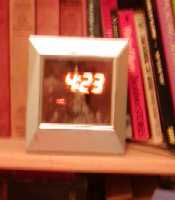 The 1906 earthquake centennial was a boorish affair — an exercise in gaudy gaucherie where the media was placed first and the people figured in last. Perhaps my feelings are tainted a bit by my recent run-in with San Francisco’s finest. But the facts don’t lie.
The 1906 earthquake centennial was a boorish affair — an exercise in gaudy gaucherie where the media was placed first and the people figured in last. Perhaps my feelings are tainted a bit by my recent run-in with San Francisco’s finest. But the facts don’t lie.
Several large LCDs were placed just outside the main congregation point, as if to suggest to the people that they may as well stay home and watch the event on television. Within the actual corner of Kearny and Geary Streets, where Lotta’s Fountain resides, if you were one of the lucky two hundred who somehow made it past the elevated island designed to convey passengers onto the F Market train, then you had a view as clear as Gavin Newsom’s complexion.
Of course, given that about 7,000 people (possibly more) showed, one couldn’t help but contemplate plutocratic metaphors.
I arrived later than expected, in large part because I walked about thirty blocks when there was no sign of the promised buses that MUNI had planned to provide around 4 AM. Fortunately, providence was on my side. And when I hit Market and Van Ness, I managed to board a bus, arriving within minutes of the 5:12 AM moment of silence. An audio report of these adventures will soon follow.
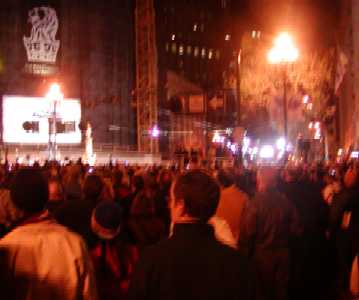 I worked my way behind the elevated island, which was occupied by all manner of media people. If this was truly an event for the people, the media pool might have been placed somewhere else. I had a better view of a personal assistant spraying goop into a reporter’s hyperconditioned hair than any portion of the stage.
I worked my way behind the elevated island, which was occupied by all manner of media people. If this was truly an event for the people, the media pool might have been placed somewhere else. I had a better view of a personal assistant spraying goop into a reporter’s hyperconditioned hair than any portion of the stage.
Indeed it seemed that we were there more for B-roll. An expensive-looking camera on a computer-operated jib rose up and down capturing the hurried crowd.
It wasn’t a good place to be if you were claustrophobic.
There were bright floodlights designed to limn attractive and well coiffed reporters. I hadn’t had a single cup of coffee yet and this did not augur well for visibility, much less coherence on my part.
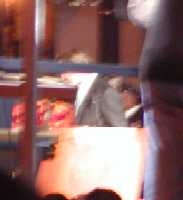 I caught a sliver of Gavin, dressed in a gray suit and spouting off all manner of treacle. He resembled a dubious faith healer more than an elder statesmen.
I caught a sliver of Gavin, dressed in a gray suit and spouting off all manner of treacle. He resembled a dubious faith healer more than an elder statesmen.
It was Our Mayor who came up with the rather cruel idea that all bells and sirens in the City should go off at 5:14 AM, meaning that those who didn’t want to take part in this celebration were doomed to remember the day anyway.
And this was the thing that troubled me. A hundred years ago, more than 3,000 people died. 225,000 were left homeless. $400 million in property was lost. (All of these numbers by the way come straight from my noggin, without Googling. I have a slight obsession with disasters and apocalypses.)
And there were more deaths, many of these shootings unnecessary, from the fascistic emergency order issued by the police designed to enforce a tight curfew.
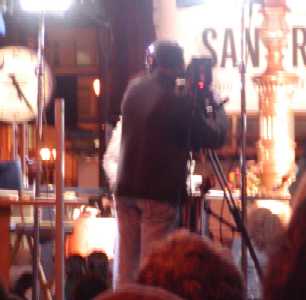 In other words, here we were at an event that was more designed as an ostentatious expose for San Francisco media. Before any of the survivors came forward to speak, the podium was given to the fire chief and the police chief. When a charming old gentleman did in fact get his time, it was more Gavin’s moment than his. I felt like I was watching some surreal talk show as Gavin asked him awkward question about what he does today (apparently, working two days a week). This was hardly a memorial for the people whose lives were lost, whose very existences were displaced, and who later fell victim to the excessive martial zeal of then-Mayor Schmit, General Funston and the military.
In other words, here we were at an event that was more designed as an ostentatious expose for San Francisco media. Before any of the survivors came forward to speak, the podium was given to the fire chief and the police chief. When a charming old gentleman did in fact get his time, it was more Gavin’s moment than his. I felt like I was watching some surreal talk show as Gavin asked him awkward question about what he does today (apparently, working two days a week). This was hardly a memorial for the people whose lives were lost, whose very existences were displaced, and who later fell victim to the excessive martial zeal of then-Mayor Schmit, General Funston and the military.
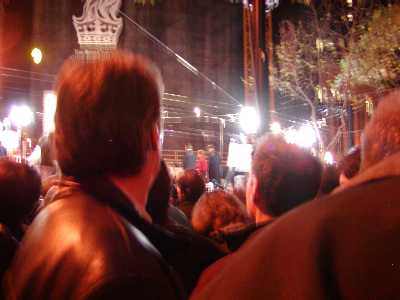 The great irony is that, being so jam-packed in the crowd, locked into place by a crowd control situation that was rather anarchic, if an earthquake were to occur at that moment and the buildings and traffic lights were to come crashing down, I’m almost positive we would have been killed.
The great irony is that, being so jam-packed in the crowd, locked into place by a crowd control situation that was rather anarchic, if an earthquake were to occur at that moment and the buildings and traffic lights were to come crashing down, I’m almost positive we would have been killed.
I did my best to record audio of the proceedings and to take pictures. But I was repeatedly pushed and shoved. And when I was elbowed in the face by a capacious and bulbous gentleman who clearly didn’t understand the Cavalieri principle, I decided to go home.
This was not a ceremony for the people. This was not a ceremony for the historians or for anyone who loves San Francisco as much as I do. In fact, it really wasn’t much fun at all. It was an event which felt, from start to finish, entirely manufactured. Which was another great irony, considering that it was the spontaneous actions of people that got my city rebuilt and, most recently, got this nation through 9/11 and Katrina.
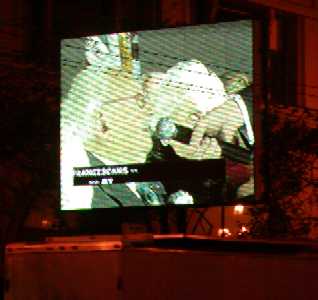 But I cheered up immensely when I hit Powell Street Station and headed home. For a gentleman with a guitar was singing the Kinks’ “Sunny Afternoon” with great ardor. Considerably off-key, but he sung with more passion than Heather Fong or Gavin Newsom could muster in their speeches.
But I cheered up immensely when I hit Powell Street Station and headed home. For a gentleman with a guitar was singing the Kinks’ “Sunny Afternoon” with great ardor. Considerably off-key, but he sung with more passion than Heather Fong or Gavin Newsom could muster in their speeches.
I smiled and gave him a dollar and knew that this guy, playing to no audience, was the San Francisco I loved and knew.
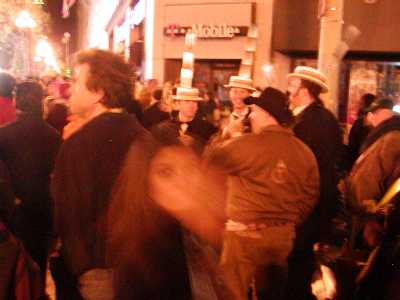
Not as many people dressed up as I thought.
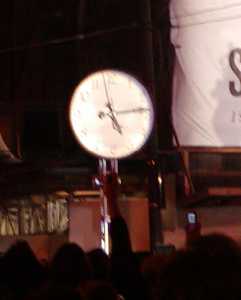
How much did this clock cost the City?
Jesus, They REALLY Want San Franciscans to Go to This
The SFist: “We’re just trying to spare you some panic tomorrow morning, folks — if you hear bells and sirens at 5:12 a.m., no need to wonder about the cosmic coincidence of an earthquake striking exactly 100 years after the big one of 1906 — it’s just Gavin Newsom, who’s ordered that all fire stations and churches ring their bells and sirens after the moment of silence at Lotta’s Fountain that traditionally commemorates the 1906 quake.”
Death! Destruction! Earthquake! Fire! Time to Celebrate!
Tomorrow at approximately 5:12 AM is the 100th anniversary of the 1906 earthquake. Your correspondent won’t be going all out like Frances, but being something of a city history junkie, your correspondent will be getting his ass up before dawn and heading down to Lotta’s Fountain. If you’ll be around, look for the guy with the headphones and the digital camera. Your correspondent hopes that a Lotta Crabtree type or two will perform.
Just My Two Cents
Any list of skylines that doesn’t include San Francisco is utterly worthless.
David Lazarus: A Journalist Who Can’t Rise from the Dead
Ethical Question: Aren’t you really setting yourself up for disaster when you email naked photos of yourself to “a variety of online correspondents?”
The whole idea that this “Gene” character is complaining after he was foolish enough to send off photos to random strangers strikes me as naive and a bit self-serving. Further, if a person attending a sex party doesn’t already know that the San Francisco sex community is a small and tight-knit group (and, by damn, they should know) and that they should be highly circumspect, do they really have the right to complain? Here’s the question: what happened at the disrupted party and why didn’t the reporter push “Gene” for an answer?
The interesting thing about David Lazarus’s “The Internet is Evil” article is that we don’t hear the other side of the story. Why didn’t Lazarus try and get in touch with “Reality Check” or other members of the Yahoo group? Surely, “Gene,” if he had any brains at all, would have had records or emails from the disabled site. Oh yeah. His story angle was the “victimized” Gene and the evils of the Internet, as pronounced from Ray Everett-Church’s high horse. Never mind that Lazarus’s article still presents us with the possibility that “Gene” could have tipped off campus police about the party and that Lazarus doesn’t even bother to get a firm “No, I didn’t call the police” from “Gene” to make his case more airtight. Nor do we have any idea about how “Gene”‘s reactions to his accusations could have provoked the fury of his cybersmearers. Did he egg them on? I’ve seen a lot of flame wars over the years, and, in most cases, it takes two to tango.
The other thing that makes this story suspect: If Gene was told implicitly by Yahoo! that he needed a subpoena, why didn’t Gene figure out that maybe he just might need an attorney to file a civil suit and hammer Yahoo! with discovery? Perhaps because Gene either lacks the funds, can’t find an attorney to take his case, or implictly knows that there’s a bit of bullshit to his story.
Sure, cybersmears are certainly a threat and I don’t mean to suggest that “Gene” is without innocence. But “Gene”‘s case is a poor example, and Lazarus’s findings here are so full of holes, lack of specifics and unanswered questions that I simply cannot buy his premise.
Sparkletack
I can’t believe I didn’t discover it until now, but Sparkletack is one excellent podcast concerning itself with the history and culture of San Francisco.
The Sony Metreon Scam
Expect the area south of Powell Street Station to turn into a consumer-centric nightmare. That’s because Westfield San Francisco has purchased the Sony Metreon complex for $70 million. Now David Lazarus might tell you that the Sony Metreon venture was a sad failure. He might imply that this was a dream that didn’t deserve to die. And he certainly paints a human face in talking with Trevor Bryant, the senior vice president who supervised the development of the Sony Metreon and who claims in Lazarus’s article, “It was supposed to be a place where you couldn’t tell where the entertainment ended and the retail began. I truly believed in it 100 percent.”
But if customers are constantly entertained, how then will they purchase products? And doesn’t it make sense to give the customer clear terms with which to purchase these products? I’m no MBA, but how can any business succeed if the customer doesn’t even know what the hell he is buying?
I smell bullshit. It seems pretty clear to me that Trevor Bryant was played for a fool.
Here’s what I think: The Sony Metreon, arriving in 2001, was one of those crazy ideas that came into fruition during the dot com days. Sony wanted presence and presence alone, not unlike the MGM Grand in Las Vegas. Alas, presence is not exactly the best of business models. Not unless you can turn a profit.
Now just as the deal gets finalized, Sony starts to get cold feet. Or, rather, they wake up. They wonder just what the hell they’ve gotten themselves into and perhaps fire the crazy bastard who convinced some top man that the Metreon was a great idea. But at this point, the deal is too far along to stop. And besides this is a really hot property development spot in San Francisco. There are all sorts of things being built nearby. An Old Navy store. An Apple store. The like. All of them constructed and developed because with Sony’s $85 million move, there’s an aura in the air that, around Fourth and Market, some serious and profitable shit is going down.
So, six months after the Metreon opens, Sony cuts off the development money it’s earmarked, per Bryant’s corroboration in the Lazarus article, and they think to themselves, “Let’s see what Bryant can do on nothing.” So Bryant works his ass off, while some transactional law and assessment division of Sony starts factoring in just who in the hell they can sell this big complex to. Meanwhile, the economy’s not doing so hot because of September 11 and the recession that lasts through 2003. Stores open, stores close. But the movie theatre is successful. But who the hell cares? Because this thing’s a big shark waiting to die.
And then the economy picks up and Westfield, who just happens to own the nearby San Francisco Shopping Centre, starts thinking about malls and monopolization. And Sony sells to them for $70 million. This may seem a bad deal. But au contraire. Because let’s consider how much Sony’s made leasing out all that space, as intermittent as it was. Let’s also factor in the strange arrangement in 2002, where Sony offered to operate a store on a retailer’s behalf, a way to accumulate a quick amount of cash and ensure that some income was coming into Sony’s coffers. Surely, much of this makes up for a $15 million shortfall, doesn’t it?
So Sony makes most, if not all, of its $85 million development money back. It gets free advertising for five years, but without having to pay for it to like Pacific Bell (later SBC, later AT&T) did for the ballpark. And the area around Fourth and Mission Streets turns, two years from now, into either a bona-fide, obscene and profitable mall or another ghost mall to decimate the landscape. One thing’s for sure: the drive to open more retail isn’t going to hinder that area’s homogenized development anytime soon.
Regardless of Westfield’s success or failure with the Metreon, Sony makes out okay on this score. But for San Francisco, the area loses any and all distinction. It’s another “bad” business deal in which many unspoken entities win, but the people lose.
Bring Out Your Undead
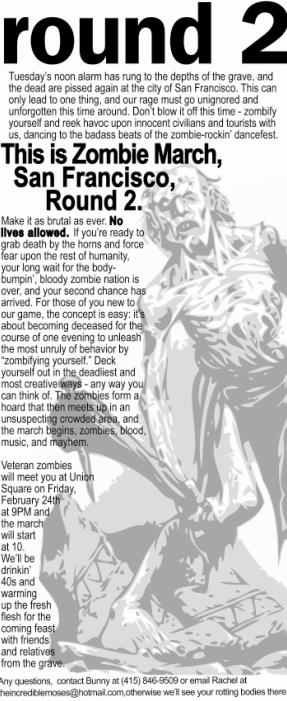
Merging Chains, Growing Pains, Shaking Up is Hard to Do
I have know idea if the Village Voice Media/New Times merger has anything to do with it, but the SFist’s Jackson West reports on the bad juju going down at the SF Weekly. Factual errors, rolling heads, and names disappearing from the masthead without so much as a note. Can a dead body be far behind?
Nextbus MUNI Secret Links
Tipped off by the fine folks at the SFist, I’ve learned that there are “secret” links to MUNI routes not listed in the main Nextbus directory, meaning that for a good chunk of MUNI’s routes, you can see exactly where the buses are in real time. (This will probably mean nothing to you if (a) you do not live in San Francisco or (b) are not a hard-core public transportation zealot. You have been warned in advance that this post contains some frighteningly pedantic information.)
This is fantastic because, at long last, MUNI riders can now capture irrefutable evidence of those two hour minute driver breaks at the end of the line. (I can second Mattymatt’s observation that the standard MUNI driver response: “Another bus will be along in a minute,” is pretty much the norm.)
Some bus lines are wired; some are not. In fact, when we examine this list, it’s interesting that nearly every route which limns the rich and superficial pockets of the Marina is listed (including the rinky-dink 41!), while the crosstown routes that serve the people who don’t wear overpriced Hugo Boss suits on a regular basis (the 29, the 38 — at 54,000 daily passengers, the nation’s busiest bus line, and the 71) aren’t wired up yet. Nor are any of the Owl lines. The latter, in particular, would be helpful for those who need to catch the only damn buses running at 3 AM and stand waiting in the shivering cold with an empty wallet and a dead cell phone (thus precluding a taxi) for 90 minutes hoping to hell the bus in question will actually stop for them.
But here’s a list of functioning links I’ve been able to find, compared against the MUNI route checklist:
F Market
J Church
K Ingleside
L Taraval
M Oceanview
N Judah
S Castro Shuttle
California Street Cable Car: Not available.
Powell-Hyde Street Cable Car: Not available.
Powell-Mason Cable Car: Not available.
1 California
1AX: Not available.
2AX: Not available.
3 Jackson
4 Sutter
5 Fulton
6 Parnassus
7 Haight
9 San Bruno: Not available.
9AX San Bruno Express: Not available.
9BX San Bruno Express: Not available.
10 Townsend: Not available.
12 Folsom: Not available.
14 Mission
14 Limited: Not available.
14 Express: Not available.
15 Third Street: Not available.
16AX Noriega Express: Not available.
16BX Noriega Express: Not available.
17 Parkmerced: Not available.
18 46th Avenue: Not available.
19 Polk: Not available.
21 Hayes
22 Fillmore
23 Monterey: Not available.
24 Divisadero
26 Valencia: Not available.
27 Bryant: Not available.
28 19th Avenue: Not available.
28L 19th Avenue Limited: Not available.
29 Sunset: Not available.
30 Stockton
30X Marina Express: Not available.
31 Balboa
31AX Balboa A Express: Not available.
31BX Balboa B Express: Not available.
33 Stanyan
35 Eureka: Not available.
36 Teresita: Not available.
37 Corbett: Not available.
38 Geary: Not available.
38 Geary Limited: Not available.
38AX Geary A Express: Not available.
38BX Geary B Express: Not available.
39 Colt: Not available.
41 Union
43 Masonic: Not available.
44 O’Shaughnessy: Not available.
45 Union-Stockton
47 Van Ness: Not available.
48 Quintara-24th Street: Not available.
49 Van Ness-Mission
52 Excelsior: Not available.
53 Southern Heights: Not available.
54 Felton: Not available.
56 Rutland: Not available.
66 Quintara: Not available.
67 Bernal Heights: Not available.
71 Haight Noriega: Not available.
71L Haight Noriega Limited: Not available.
76 Marin Headlands: Not available.
80X Gateway Express: Not available.
81X Caltrain Express: Not available.
82X Presidio & Wharves Express: Not available.
88 BART Shuttle: Not available.
89 Laguna Honda: Not available.
90 Owl: Not available.
91 Owl: Not available.
108 Treasure Island: Not available.
Calling All Noir Geeks
Eddie Muller’s Noir City starts up again next month. And this time, he’s got both the Balboa and the Place of Fine Arts to program his films. There are some fantastic films on the list. If you haven’t seen They Live by Night or Thieves’ Highway, then you’re seriously missing out.
Stranger Than Fiction
Bus ride home. An ordinary route going through fairly safe neighborhoods. The 7. Kids sitting in the front seats laughing. Me reading book as usual.
Long-haired man with smoky colored hair, flannel shirt. Suddenly, there’s a pungent smell. Man has crack pipe, smoking it. Smiles at adjacent kids and offers pipe. “Hey, you kids wants some?” Mothers horrified. Fantastic shouting. Demands for crackhead to get off bus. “Driver, this man is doing drugs!” Bus packed, tired people at end of workweek provoked with fury. Lacking tar and feather, they let man loose. Not even a third of the way through ride.
Me, back to book. Interrupted by strange moisture against my left hand. Look to left. Solar plexus tightens. One of those dogs popping its head out of the bag. I meet its gaze and it starts barking loudly. A little thing full of piss and vinegar. Owner placates it with hand. The dog likes to be scratched behind the ears. I get the sense that it’s spoiled to death at home, even when it pisses on the carpet in a moment of weakness.
Me, book now fully out of the question. Now hypervigilant. Waiting for bus to explode. What Fellini film am I in?
Man gets on dressed in bright clown bowtie, denim jacket, white pants with stains, in short a fashion statement, standing up without holding onto the rail, actually arching his back back as the bus moves uphill. Does he know the Alexander technique? How the hell does he manage this while the bus is in motion?
Dog looks at me as if nothing happened, stretching head out of bag, tongue dangling to lick my hand again, which is no longer there seeing as how I’m no longer holding a book. In fact, my arms are crossed. Dog cants his head and, to me, it looks likely that he might have a second head.
Couple get on board. There’s three stops to go. Man is early twenties, dressed in what looks like a cheap Brook Brothers suit, hasn’t yet learned how to tie a necktie properly. Woman is considerably older, perhaps forty-seven, makeup caked over her face. They start making out like teenagers. Woman actually reaches for man’s crotch and starts petting his cock beneath his trousers. The kids, thankfully, are gone.
Arrive home. Lock the door. Push chair against it just to be sure. Maybe it’s a night in for me after all.
Fusion City
I really wish I could make this, but other pressing obligations keep me chained to the computer (and likely will result in scattershot updates for the first half of this week). But if you’re in San Francisco tonight, check out Kate Braverman’s Fusion City, “a literary talk show,” over at Edinburgh Castle. She’ll be talking with Kim Addonizio, Charlie Anders, Katai Noyes and Michelle Richmond. Plus, there will be a performance artist named Daphne Gottlieb.
A Tip for Balding California Men (Like Me)
I didn’t know this, but in Lodi, Gary’s Uptown Restaurant offers balding (and the balder, the better) men free dinner on Wednesdays. (The funny thing about the clip: A bald woman and a bald man go on a first date to get the discount. And the only guy sitting alone has a full head of hair.)
Movin’ On Up
2004: San Francisco is the 10th most literate city.
2005: San Francisco is the 5th most literate city.
New York City, the publishing capital of the nation, is nowhere to be found either year.
Edward Guthmann, Plagiarist?
Looks like San Francisco Chronicle reporter Edward Guthmann has been caught plagiarizing the New Yorker. I’m truly sorry to hear this, as I had several great conversations with Guthmann back in the days when I practiced film criticism and though him a decent person and a decent writer. Knowing what little I know about Guthmann, I’m truly shocked that he did this.
[1/25/06 UPDATE: I’ve been in touch with Edward Guthmann. There are a few things that should be noted:
1. According to this SF Weekly piece, Guthmann confesses that the so-called plagiarism was unintentional, “During the months I worked on the piece, I gathered a huge amount of research and interview transcripts that I stored in computer files. At one point, I read about the 1,000th suicide in the New Yorker article and pasted two sentences in my text as a ‘flag’ — a reminder to myself to mention the fact. But when I went back to the piece, which may have been days later since I had other work during that time, I forgot those weren’t my words. I should have set them in boldface or larger type, or not moved them at all. Huge mistake — and especially heartbreaking, since I worked so hard on the piece and, apart from those two sentences, I think it’s my best work.”
2. During the course of the online investigation, nobody (including myself) thought to contact Guthmann himself. While the Vidiot’s coverage was quite fair, hopefully this will serve as a reminder to bloggers that it’s important to hear multiple sides of the story, particularly the persons who are accused of the charges.
I leave all the results here for readers to make up their minds.]
[1/25/06 UPDATE 2: Vidiot informs me that Guthmann was cc’d in his email to the Chronicle ombudsman. So there were some efforts to contact Guthmann.]
ASCII Research
Here’s a nifty map of my neighborhood in ASCII, based on the Rolling Stone “Pilgrimage Places in the Haight” map in 1976.
O’Really?
The fool dissed my hometown.
O’Reilly can say whatever he wants about San Francsico. I don’t give a shit. But when he advocates the destruction of the Coit Tower by terrorists and the resultant loss of life, I have to wonder what O’Reilly fans see in such a man.
Voting Problems in San Francisco?
At the Page Street Library, there’s something crooked going on.
I voted this morning. Not only was the Eagle machine which recorded my vote malfunctioning (it took about eight tries before the Eagle machine took the ballot, but the lady (whose name, I have discerned, is Irena) actually looked at my ballot and said to me, “Are you sure you want to vote that way?” Further, I did not receive a voting stub back from my ballot. Just the offer of an orange sticker that said “I voted today.” Did my vote even count this morning? Was the machine even recording my results right? Further, are Irena’s remarks swaying other voters from making an informed decision?
I wasn’t the only person subject to Irena’s catty questions. My neighbor also experienced this.
I am greatly shocked by all this. I have voted in every election since I was 18 and have never once seen such political influence, in clear violation of election laws, maintained within the inner sanctum like this.
I’ve tracked down the appropriate person (a very nice lady named Hortensia) at the San Francisco Department of Elections and got them to pledge to replace the Eagle machine and look into Irena’s corrupt behavior today.
Needless to say, if anyone else in San Francisco is experiencing anything fishy, please let the Department of Elections know about this. The phone number is 415-554-4375.
In Which Jennifer Weiner Is Assaulted by the Marina People
Jennifer Weiner is back home and she notes this strange question about a woman asking her at the San Francisco Barnes & Noble if she was “self-actualized.” This is not much of a surprise, as this Barnes & Noble is very close to the Marina. Such strange terminology is bandied about by residents there on a daily basis. Although for those of us in the Haight and the Mission, we would never think of asking any distinguished lady if she was “self-actualized,” as most living bipedal mammals, are by their very nature already quite actualized by way of living, breathing, thinking and feeling. On behalf of my fellow San Franciscans, I apologize to Ms. Weiner for being frightened by the Marina people and hope that the publicists book her in safer quarters for the next book.